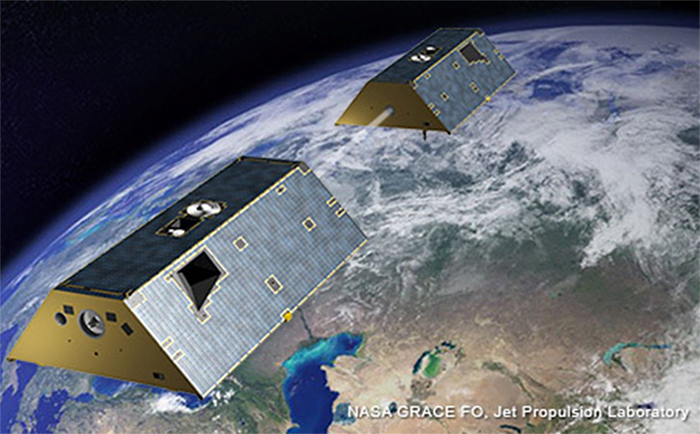
Gravity is different on different places on Earth. And gravity can change when masses on or in Earth shift—like in an earthquake or volcanic eruption. Or when a polar ice sheet melts or calves into the sea. Or even when groundwater levels change. It’s this last one we’ll take a closer look at—from space.
Fifteen years ago, NASA launched the Gravity Recovery and Climate Experiment, or GRACE. It’s a pair of satellites with a codependency issue. Rather than measuring Earth’s surface, they keep track of each other. In particular, their exact distance from one another, down to the micron.
When the first satellite passes over a place on Earth with greater gravity, it speeds up very, very slightly, and the distance between the satellites increases—by less than the width of a human hair. When it passes over an area with lower gravity, the distance decreases.
By tracking the expanding and contracting distances between each other, over 2.5 billon miles of Earth orbits, the pair has given us a more accurate picture of our varying gravity than ever before, which has revealed something very important.
Humans have never been able to measure groundwater well. But by sensing the shifting gravity as the water is depleted, the satellites have found that, under many cities in deserts, groundwater reserves have declined by two-thirds since they started measuring, putting these communities at serious risk.
With this remarkable data from space, we can better manage our water resources here on Earth.
Background
Synopsis: Earth’s gravity is constantly changing because of tectonic forces and climatic variation on its surface. The GRACE (Gravity Recovery and Climate Experiment) twin satellites have simply and elegantly followed changes in Earth’s gravitational pull for 15 years with extraordinary results, particularly in hydrology, having dramatic implications for civilization. New satellites launch in 2018; the first pair lasted five times longer than expected.
- Earth’s gravity field is constantly shifting because its dynamic surface processes cause local changes in mass that occur on shorter time scales. These changes can be tracked as the “time variable” gravity field over periods of years, recording:
- Redistribution of mass from tectonic events like volcanic eruptions and earthquakes.
- Changing mass of polar ice sheets and distribution of ocean currents.
- Shifting masses of groundwater and even soil moisture.
- To help scientists better understand these changes, NASA and the German Aerospace Center (DLR) launched the GRACE mission on March 17, 2002.
- Twin GRACE satellites fly 137 miles apart, looping Earth about every 90 minutes in a polar orbit at about 300 miles altitude; they cover the whole planet each 30 days.
- Unlike other satellites, they don’t measure something on the surface of Earth; rather, they measure the impact of Earth’s gravitational field on each other.
- As the pair orbits, the first satellite is tugged away from the second when it passes over stronger gravitational fields on Earth’s surface; when the second passes over the stronger field, it catches up to the first. A precise microwave ranging system measures the nearly imperceptible changes in distance measured in microns, a fraction of the width of a human hair.
- After about 2.5 billion miles, the twins are running out of fuel, even though they have been using solar panels when possible. So in early 2018, the GRACE-FO mission will launch, with twin satellites sporting more-precise laser-measurement capabilities, to continue the work of the original pair.

- Over the past 15 years, GRACE has revealed changes in many natural processes, ranging from thinning of ice sheets to flow of water in river basins, aquifers, and ocean currents to flow of magma within Earth.
- Some of the most important findings have to do with groundwater, which civilization depends upon. Because groundwater is normally hidden underground, we don’t actually know how much exists on Earth.
- GRACE results provide a visual display of gravity changes over a particular area each month to help understanding of rates of change in water volume.
- In a recent study of global basins, consistent gravity decreases show that the rate of drawdown of aquifers is outpacing recharge from rainfall in more than two-thirds of the basins. One-third of the reserves are in severe distress, many in large population centers in desert areas—a serious threat.

